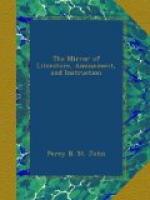Lord Byron’s Haidee is a copy of Juliet in the Oriental costume, but the development is epic, not dramatic.
I remember no dramatic character, conveying the same impression of singleness of purpose, and devotion of heart and soul, except the Thekla of Schiller’s Wallenstein: she is the German Juliet; far unequal, indeed, but conceived, nevertheless, in a kindred spirit. I know not if critics have ever compared them, or whether Schiller is supposed to have had the English, or rather the Italian, Juliet in his fancy when he portrayed Thekla; but there are some striking points of coincidence, while the national distinction in the character of the passion leaves to Thekla a strong cast of originality.
With regard to the termination of the play, which has been a subject of much critical argument, it is well-known that Shakspeare, following the old English versions, has departed from the original story of Da Porta;[7] and I am inclined to believe that Da Porta, in making Juliet waken from her trance while Romeo yet lives, and in his terrible final scene between the lovers, has departed from the old tradition, and as a romance, has certainly improved it: but that which is effective in a narrative is not always calculated for the drama; and I cannot but agree with Schlegel, that Shakspeare has done well and wisely in adhering to the old story.[8] Can we doubt for a moment that Shakspeare, who has given us the catastrophe of Othello, and the tempest scene in Lear, might also have adopted these additional circumstances of horror in the fate of the lovers, and have so treated them as to harrow up our very souls—had it been his object to do so? But apparently it was not. The tale is one,
Such, as once heard, in gentle heart destroys
All pain but pity.
[7] The “Giulietta” of Luigi da Porta was written about 1520. In a popular little book published in 1565, thirty years before Shakspeare wrote his tragedy, the name of Juliet occurs as an example of faithful love, and is thus explained by a note in the margin. “Juliet, a noble maiden of the citie of Verona, which loved Romeo, eldest son of the Lord Monteschi; and being privily married together, he at last poisoned himself for love of her: she, for sorrow of his death, slew herself with his dagger.” This note, which furnishes in brief, the whole argument of Shakspeare’s play, might possibly




